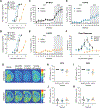Unique pharmacodynamic properties and low abuse liability of the µ-opioid receptor ligand (S)-methadone
- PMID: 38145984
- PMCID: PMC11221360
- DOI: 10.1038/s41380-023-02353-z
Unique pharmacodynamic properties and low abuse liability of the µ-opioid receptor ligand (S)-methadone
Abstract
(R,S)-methadone ((R,S)-MTD) is a µ-opioid receptor (MOR) agonist comprised of (R)-MTD and (S)-MTD enantiomers. (S)-MTD is being developed as an antidepressant and is considered an N-methyl-D-aspartate receptor (NMDAR) antagonist. We compared the pharmacology of (R)-MTD and (S)-MTD and found they bind to MORs, but not NMDARs, and induce full analgesia. Unlike (R)-MTD, (S)-MTD was a weak reinforcer that failed to affect extracellular dopamine or induce locomotor stimulation. Furthermore, (S)-MTD antagonized motor and dopamine releasing effects of (R)-MTD. (S)-MTD acted as a partial agonist at MOR, with complete loss of efficacy at the MOR-galanin Gal1 receptor (Gal1R) heteromer, a key mediator of the dopaminergic effects of opioids. In sum, we report novel and unique pharmacodynamic properties of (S)-MTD that are relevant to its potential mechanism of action and therapeutic use. One-sentence summary: (S)-MTD, like (R)-MTD, binds to and activates MORs in vitro, but (S)-MTD antagonizes the MOR-Gal1R heteromer, decreasing its abuse liability.
© 2023. This is a U.S. Government work and not under copyright protection in the US; foreign copyright protection may apply.
Conflict of interest statement
Competing Interests
MM has received research funding from AstraZeneca, Redpin Therapeutics, and Attune Neurosciences. Dr. Zarate is a full-time U.S government employee. He is listed as a coinventor on a patent for the use of ketamine in major depression and suicidal ideation. Dr. Zarate is listed as a coinventor on a patent for the use of (2R,6R)-hydroxynorketamine, (S)-dehydronorketamine and other stereoisomeric dehydro and hydroxylated metabolites of (R,S)-ketamine metabolites in the treatment of depression and neuropathic pain. Dr. Zarate is listed as co-inventor on a patent application for the use of (2R,6R)-hydroxynorketamine and (2S,6S)-hydroxynorketamine in the treatment of depression, anxiety, anhedonia, suicidal ideation and post-traumatic stress disorders. Dr. Zarate has assigned his patent rights to the U.S. government but will share a percentage of any royalties that may be received by the government.
Figures




Update of
-
Unique pharmacodynamic properties and low abuse liability of the μ-opioid receptor ligand (S)-methadone.Res Sq [Preprint]. 2023 Mar 23:rs.3.rs-2644719. doi: 10.21203/rs.3.rs-2644719/v1. Res Sq. 2023. Update in: Mol Psychiatry. 2024 Mar;29(3):624-632. doi: 10.1038/s41380-023-02353-z. PMID: 36993715 Free PMC article. Updated. Preprint.
References
-
- Dole VP, Nyswander M. A Medical Treatment for Diacetylmorphine (Heroin) Addiction. A Clinical Trial with Methadone Hydrochloride. Jama 1965; 193: 646–650. - PubMed
-
- Chem KK. Pharmacology of methadone and related compounds. Ann N Y Acad Sci 1948; 51(Art 1): 83–97. - PubMed
-
- Fava M, Stahl S, Pani L, De Martin S, Pappagallo M, Guidetti C et al. REL-1017 (Esmethadone) as Adjunctive Treatment in Patients With Major Depressive Disorder: A Phase 2a Randomized Double-Blind Trial. The American journal of psychiatry 2022; 179(2): 122–131. - PubMed
Publication types
MeSH terms
Substances
Grants and funding
- PID2020-113938RB-I00/Ministry of Economy and Competitiveness | Agencia Estatal de Investigación (Spanish Agencia Estatal de Investigación)
- PID2022-140912OB-I00/Ministry of Economy and Competitiveness | Agencia Estatal de Investigación (Spanish Agencia Estatal de Investigación)
- DA049257/U.S. Department of Health & Human Services | NIH | National Institute on Drug Abuse (NIDA)
- ZIA DA000493/ImNIH/Intramural NIH HHS/United States
- Juan de la Cierva fellowship FJC2019-041020-I/Ministry of Economy and Competitiveness | Agencia Estatal de Investigación (Spanish Agencia Estatal de Investigación)
- R01 DA049257/DA/NIDA NIH HHS/United States
- ZIA DA000069/ImNIH/Intramural NIH HHS/United States
- ZIA DA000522/ImNIH/Intramural NIH HHS/United States
- 2021-SGR-00230/Generalitat de Catalunya (Government of Catalonia)
- ZIA000522/U.S. Department of Health & Human Services | NIH | National Institute on Drug Abuse (NIDA)
LinkOut - more resources
Full Text Sources
Research Materials

